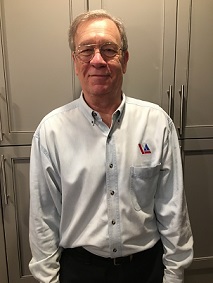Consumer Involvement




On April 25, 1969, almost two months post-deployment to Vietnam, infantryman Jim Mayer sustained a life-threatening injury that, he says, “totally changed my life and not just physically. There were immediate and long-term changes.” During his time in combat, Jim recalls witnessing death and severe injuries. On April 25, 1969, Jim tripped a Viet Cong land mine.
“I didn’t lose consciousness. I was aware of everything. I could see that my left leg was traumatically amputated and my right leg was still attached, but in the shape of an L. When a friend reached me with the medic, I immediately said that I would live.”
During his 10-month stay in an Army hospital in Texas, as a bilateral below-the-knee amputee, Jim was surrounded by 40 other amputees when he recognized two things, “I realized that plenty of soldiers were in worse shape than me and everyone helped bring each other along via friendships, listening to and motivating each other.”
Jim had received his bachelor’s degree in business administration prior to his Army enlistment. After returning home to his family and friends, he returned to his alma mater to obtain a bachelor’s degree in education. He got active in the campus veterans club and notes that participation “really changed me. It reminded me of everyone pulling together in the amputee ward and re-awakened something within me – how good it feels to help people, especially your peers.”
Rejuvenated by the desire to be of help, from 1972 to 1974 Jim was elected the unsalaried president of the National Association of Collegiate Veterans (NACV; later the National Association of Concerned Veterans). He and five other volunteer vets moved to Washington, DC and opened an office to advocate for improved readjustment benefits. He cites some notable NACV successes including a 23% increase in the GI Bill for education benefits in their first year, the 10-year battle to have PTSD recognized as a diagnosis, and with pro-bono representation by Public Citizen won the first anti-impoundment lawsuit during the Nixon administration – allowing money appropriated by Congress to be used for its intended purpose. Jim then held several positions in the Department of Veterans Affairs (VA) and with the Paralyzed Veterans of America before retiring in June 2007 from the VA.
One week later, Jim went to work for the Wounded Warrior Project (WWP) and retired again in March 2016. Jim describes how he helped create a WWP peer mentoring program as “very rewarding. We trained wounded, injured, and ill Global War on Terrorism veterans who had achieved recovery to be mentors for their more recently disabled peers. Those opportunities to make bedside visits at military and VA hospitals reinforced my respect for a truly unique group of people that have recovered from tragedy and then pay it forward.”
Jim remained an active volunteer during his working career. In January of 1991, Jim began volunteering at Walter Reed Army Medical Center. He later became an Amputee Coalition Amputee Peer Visitor and Trainer. In 2004, his volunteer work on the hospital wards was depicted by Garry Trudeau in the comic strip Doonesbury as Jim, the “Milkshake Man.” In October 2003, Jim began another special volunteer role, assisting with the weekly Friday night steak dinners at various venues in the D.C. area. He notes, “For the past 15 years and 9 months, I’ve been able to co-host gatherings, Friday Night Dinners, for wounded, injured, or ill service members and families. It all began at Fran O’Brien’s Stadium Steakhouse by Hal Koster, the owner and an Army helicopter gunship crew chief that served 27 consecutive months in the Vietnam. In the beginning, we would drive everyone and as more and more veterans and family members wanted to attend the dinners, the Disabled American Veterans (DAV) began providing free use of a wheelchair lift equipped bus and a driver. At one time we had 120 people at the dinners! In 2006, Fran O’Brien’s closed and Hal formed the Aleethia Foundation to continue this unique bonding opportunity for what many returning warriors say is their first taste of normal. We have served over 60,000 meals and met over 2,000 Warriors, staying in touch with many. This is a very special part of my life and I get an internal feeling that we’re making a difference.”
Jim’s current volunteer activities include being a member of the Board of Directors and Executive Committee of the Guide Dog Foundation for the Blind and America’s VetDogs and member of the Executive Council and Immediate Past President of the VA Alumni Association, a social organization of retired VA employees.
Recently, Jim got to witness Sully -- President George H.W. Bush’s former service dog, who was originally bred, raised, trained, and placed by America’s VetDogs -- be sworn in as a Navy hospital corpsman facility dog at Walter Reed National Military Medical Center.
For the past seven years, Jim has been involved with the Peer Reviewed Orthopaedic Research Program (PRORP) as a consumer reviewer. He noted that it started when he was contacted by Ann Dodelin, who assists the CDMRP in consumer recruitment. Regarding his experience as a consumer reviewer for the PRORP, he explains, “it requires a lot of work before the meeting. I find myself looking up medical terms so I can dig into the research. I am amazed by the amount of knowledge on the panels. What is graphic to me is how everyone at the meeting leans in when consumers comment on the application and perceived outcomes. I felt like an equal member on every panel I’ve served on and appreciate the need to be factual and open-minded during discussions. The CDMRP is the heart and soul of military medicine and helps to keep pushing the envelope. I know several people that received osseointegration implants (OI) and have seen the difference this research can make, so I’m a believer. It’s exciting. Go for it – implants, robotics, limb transplants, all of it!”
Last updated Monday, March 10, 2025














